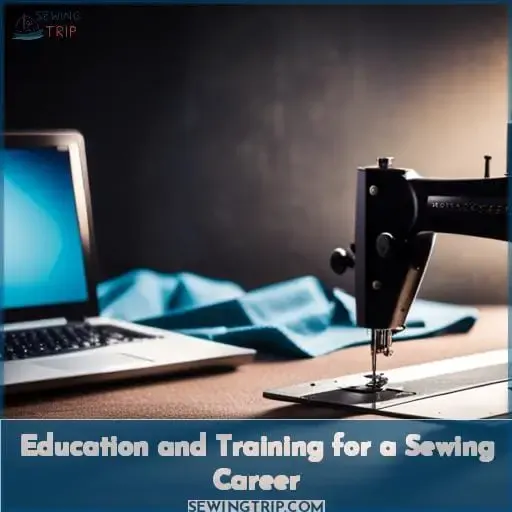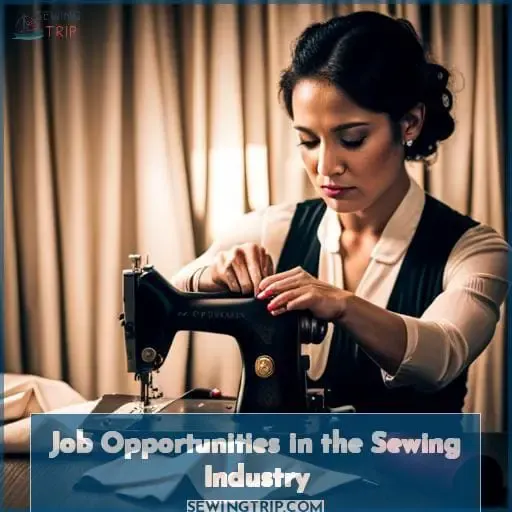This site is supported by our readers. We may earn a commission, at no cost to you, if you purchase through links.
 Embark on the transformative journey of turning your sewing passion into a fulfilling career.
Embark on the transformative journey of turning your sewing passion into a fulfilling career.
Sewing Careers Unveiled: Pathways, Opportunities, and Success Tips is your guide to navigating the diverse landscape of the sewing industry. Explore the potential, discover varied pathways, and learn the keys to building a successful career.
From education and job opportunities to overcoming challenges, this article equips you with insights, fostering your path to mastery in the world of stitches and fabrics.
Your sewing aspirations are poised for liberation and innovation – let’s unravel the possibilities together.
Table Of Contents
Key Takeaways
- There are various educational pathways available for learning sewing skills, including vocational programs, degree programs, and apprenticeships.
- Sewing professionals are in demand across industries like fashion, costume design, and textiles.
- Jobs like fashion designer, seamstress/seamster, costume designer, and tailor provide career opportunities.
- Consider challenges like physical demands, long hours, high competition, and potential for injuries before pursuing this path.
Can Sewing Become a Career?
Are you passionate about sewing?
You can turn your passion into a career by:
- Exploring different pathways
- Developing your skills
- Gaining experience
With hard work and dedication, you can achieve your sewing career goals.
Understanding the Potential
Discovering whether sewing can transform into a viable career hinges on your dedication, skills, and industry demand.
The potential for growth in the sewing industry is influenced by market demand for talented seamstresses and designers.
By investing in skill development and gaining industry insights through sewing education, you can position yourself for success.
Understanding the career paths available within the sewing industry will provide valuable guidance as you pursue a fulfilling and lucrative profession.
Exploring Different Pathways
You can delve into various avenues to turn sewing into a viable and fulfilling career.
Exploring techniques and industry insights through hands-on practice is pivotal.
Develop technical skills and consider vocational programs for job training to bolster your seamster credentials.
These programs offer occupational credentials, enhancing your potential in this craft.
By immersing yourself in diverse career trajectories, you pave the way for innovation and mastery in the sewing industry.
Developing Skills and Expertise
Frequently, individuals actively cultivate sewing skills to establish a promising career in the textile industry. Skill mastery goes beyond basic techniques, embracing a spectrum of creative exploration.
Practical experience and industry immersion augment formal training, fostering resilience and adaptability. Communication, a vital soft skill, accompanies technical prowess, shaping a well-rounded sewing professional.
Continuous perseverance in learning, coupled with on-the-job training, fortifies one’s trajectory in this dynamic field amidst a stable job outlook.
Education and Training for a Sewing Career
When it comes to pursuing a sewing career, there are various paths for education and training that can help you develop the necessary skills.
- Vocational programs and certifications offer focused training in sewing techniques, fabric selection, alterations, and more.
- Degree programs in fashion design or textiles provide a broader understanding of the industry and may include courses specifically tailored to sewing.
- Additionally, apprenticeships and on-the-job training opportunities allow you to gain hands-on experience under the guidance of experienced professionals.
Vocational Programs and Certifications
To pursue a career in sewing, consider enrolling in vocational programs and earning relevant certifications. This path offers specialized training in various aspects of sewing and textile production.
- Industry credentials, enhancing your skills as a sewer or alterations specialist.
- Vocational opportunities offer hands-on experience, crucial for mastering this craft.
- Certifications and apprenticeships bolster your expertise, setting you apart in the competitive sewing landscape.
Degree Programs in Fashion Design or Textiles
Transitioning from vocational programs and certifications, individuals passionate about a sewing career often delve deeper into specialized education, pursuing degree programs in Fashion Design or Textiles to broaden their expertise and refine their artistic craft.
These programs offer benefits like in-depth sewing skill refinement, fabric selection mastery, and industry-relevant curriculum insights. They also pave the way for diverse fashion jobs, fostering industry connections and allowing for specialization options critical in today’s competitive sewing career landscape.
Apprenticeships and On-the-Job Training
Consider embarking on an apprenticeship or seeking on-the-job training to refine your sewing skills and gain invaluable hands-on experience within the industry.
These mentorship programs offer practical training, allowing you to work alongside experienced professionals such as tailors, machine operators, or alterations managers.
Through this hands-on learning, you’ll hone your craft, mastering techniques, and gaining insights that transcend formal education, propelling you toward sewing career success.
Job Opportunities in the Sewing Industry
In the realm of sewing careers, various avenues await your expertise, encompassing roles like:
- Fashion Designers
- Seamstresses/Seamsters
- Costume Designers
- Tailors
- Textile and Apparel Technologists
These diverse roles offer a spectrum of opportunities to fuse creativity with technical mastery, allowing you to contribute to the industry’s vibrant landscape through design, fabrication, and craftsmanship.
Each role holds its distinct challenges and rewards, promising a fulfilling journey within the sewing industry.
Fashion Designers and Seamstresses/Seamsters
If you’re passionate about sewing and have a knack for fashion, there are numerous job opportunities available as a fashion designer or seamstress/seamster.
Within this vibrant industry, explore fashion evolution, textile trends, and design innovation.
Your expertise in sewing techniques and material mastery contributes to garment creation and custom clothing.
Gain relevant experience to excel in sewing duties, shaping the future of the fashion industry.
Costume Designers and Tailors
As a costume designer or tailor in the sewing industry, you’ll:
- Craft and customize garments for performances or individual preferences.
- Engage in fabric innovation and historical costume inspiration, employing meticulous tailoring techniques.
- Stay attuned to costume design trends, ensuring a custom design process that demands dexterity and unparalleled attention to detail.
This role embraces the fusion of creativity and precision, providing liberation through unique, tailored expressions in clothing.
Textile and Apparel Technologists
To delve further into the diverse scope of sewing careers, textile and apparel technologists play a pivotal role in the industry’s innovation and advancement, leveraging technology and expertise for garment production and material development.
These professionals specialize in fabric technology, championing sustainable fashion through innovative manufacturing processes. Their contributions drive industry trends, bridging the gap between material handling and cutting-edge textile innovations, impacting the entire production chain from conception to consumer.
Building a Successful Sewing Career
When aiming to build a successful career in sewing, prioritize networking to create connections within the industry, allowing opportunities to flow.
Crafting a compelling portfolio showcasing your skills and projects becomes your visual resume, an indispensable tool for securing roles and projects.
Continuous learning and skill enhancement remain pivotal, ensuring you stay ahead in this dynamic and evolving field.
Networking and Building Connections
By actively engaging with industry professionals and attending relevant events, you’ll forge vital connections crucial for cultivating a successful sewing career.
To build your network in the sewing industry, consider these strategies:
- Attend industry events and conferences to meet fellow professionals.
- Join sewing groups or associations to connect with like-minded individuals.
- Reach out to experienced professionals for mentorship or advice.
- Participate in competitions and volunteer for causes related to sewing.
Networking can open doors and create opportunities that will propel your career forward.
Creating a Portfolio and Showcase Your Work
Networking and building connections is crucial for success, so create a portfolio and showcase your work to potential employers.
Use online portfolio platforms, maintain a strong social media presence, and include process photos and clear descriptions in your portfolio.
Continuous Learning and Skill Enhancement
Supplementing your formal education with additional knowledge is crucial for continuous learning and skill enhancement.
To build a successful sewing career, you must utilize diverse resources and go beyond what you learned in school.
Embrace hands-on experience to truly master your craft.
Overcome the fear of making mistakes, as they’re inevitable in any creative pursuit. By accepting this inevitability, you can learn from your mistakes and grow both personally and professionally.
Challenges and Considerations in a Sewing Career
As you explore sewing careers, it’s important to consider the challenges and considerations involved.
Job market competition is fierce, and the physical demands and long hours can be demanding.
You’ll also need to think about the financial aspects of a sewing career, including income potential and investment costs.
Job Market Competition
One challenge to consider when pursuing a sewing career is the competitive job market.
With high demand and low supply, you must differentiate yourself through:
- Niche specialization,
- Entrepreneurial drive towards self-employment or freelancing,
- And a willingness to start in adjacent roles like researcher or quality control manager while continuing to build expertise.
There are growing industry opportunities, but expect competition. By identifying unique needs, you can carve out your place.
Physical Demands and Long Hours
You’re also looking at potential physical strains like:
- Sore wrists or back pain from long hours hunched over a sewing machine or cutting table.
- Repetitive motions like sewing can lead to injuries like carpal tunnel syndrome over time.
- Sitting for extended periods can cause back issues as well.
Make sure to take breaks, stretch, and maintain good posture.
Eye strain from close work and occasional tight deadlines in roles like retail merchandiser or cutter are realities too.
With self-care, ergonomic equipment, and balancing your workload, you can mitigate risks in product designer, customer service, and other sewing careers.
Financial Considerations and Income Potential
When embarking on a sewing career, you’ll need to weigh the financial realities as incomes can vary widely depending on your niche, clientele, and business savvy.
Research average wages, which are around $17 hourly or $35,000 yearly, though the top 10% make over $57,000.
Employment outlook shows little change, so enhance skills and build a portfolio to be competitive.
Consider part-time work or combining sewing with related roles like design or personal shopping.
Finding Success and Fulfillment in a Sewing Career
To find success and fulfillment in a sewing career, you need passion and dedication.
Your love for sewing will drive your motivation to continuously improve your skills and seek out new opportunities.
Additionally, finding your niche or specialization within the industry will allow you to showcase your unique talents and stand out from the competition.
Balancing creativity with strong business skills is also crucial for long-term success in a sewing career, as it allows you to not only create beautiful garments but also effectively market yourself and manage finances.
Passion and Dedication
Pathways, Opportunities, and Success Tips:
To find success and fulfillment in a sewing career, it’s essential to have a strong passion and dedication for the craft.
Embrace mistakes as opportunities to learn.
Continuously improve through failure and persist without giving up.
Be your own best teacher, pushing yourself to grow.
Immerse yourself fully and let your passion fuel self-motivation to master innovative techniques.
Love the learning process, and your dedication will drive career rewards.
Finding Your Niche and Specialization
One key to fulfillment is identifying your distinct talents within sewing to build expertise around them. You’d then be positioned as a specialist, gaining recognition and deeper career satisfaction by excelling in a particular area.
- Historical costume creation
- Wedding and formalwear alterations
- Quilting and embroidery
- Custom home decor items
Balancing Creativity and Business Skills
How can you blend your creative talents with the practical demands of running a sewing business?
Align your artistic vision with business acumen through market research, creative problem solving, and entrepreneurship.
Understand client needs while expressing your unique talents.
Blend analytical thinking with your gifts for design to build a sustainable company.
Consider partnerships to complement skills you lack.
Stay passionate in your creative pursuits while strategically meeting consumer interests.
Frequently Asked Questions (FAQs)
What is the average salary for a seamstress or tailor?
Approximately $35,430 per year or $03 per hour is the average salary for a seamstress or tailor in the United States.
Those with occupational experience and strong technical skills can earn over $57,000 annually.
Building expertise takes time, but this creative career path offers rewarding opportunities.
How can I build a portfolio to showcase my sewing skills?
Photograph and catalog your creations, detailing construction techniques. Share on social media and your website, highlighting custom work. This showcases range, skill set, and client satisfaction essential for establishing credibility.
What types of sewing certifications are available and how do I earn them?
To earn sewing certifications, explore programs and institutions that offer specialized training.
Develop your technical skills through hands-on experience and consider apprenticeships for mentorship.
Embrace the journey of mastering this craft while pursuing a fulfilling career in sewing.
Is it better to be self-employed or work for a company as a seamstress?
Working independently allows more creativity and control, but has financial risks.
Employment provides steady income and resources, yet limits customization freedom.
Weigh priorities – reliable income or creative liberty.
What sewing tools and equipment do I need to get started?
Start with:
- Shears
- Needles
- Thread
- Measuring tape
- Pins
- Seam ripper
As skills grow, add:
- Machine
- Iron
- Patterns
- Extra tools
Focus first on fundamentals.
Conclusion
Like a tapestry woven from passion and perseverance, a sewing career interlaces creativity, skill, and purpose.
As you stitch each experience into the fabric of your journey, new patterns and textures will emerge, bringing deeper fulfillment.
So if you feel called to turn stitches into a livelihood, take the thread and begin – a life’s work of artful meaning awaits.











